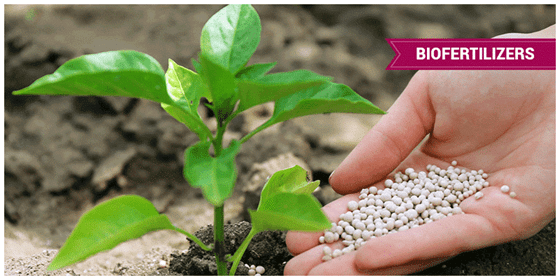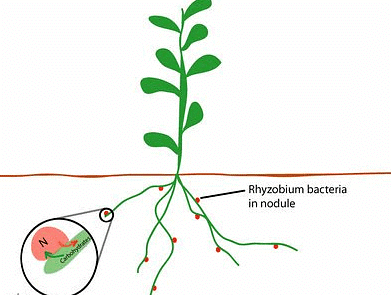Microbes as Biocontrol Agents & as Biofertilizers | Biology Class 12 - NEET PDF Download
| Table of contents |

|
| What is Biocontrol? |

|
| Biocontrol Agents |

|
| Biofertilizers |

|
| Types of Biofertilizers |

|
| Components of Biofertilizers |

|
| Importance of Biofertilizers |

|
| Applications of Biofertilizers |

|
Microbes or microorganisms are tiny single-celled creatures. They are small enough not to be seen by our naked eyes. Some microbes are useful in human welfare while others are harmful and toxic and make us ill. Let’s take a glance at the role of microbes as biocontrol agents.
What is Biocontrol?
The natural method of eliminating and controlling the insects, pests and other disease-causing agents using their natural, biological enemies is called biocontrol or biological control.
The agents which are employed for this are called biocontrol agents. Microbes are one of them. Biocontrol works on the principle of predation and parasitism. It is much reliable and healthier than killing insects and pest using insecticides and pesticides. Thus, this prevents soil pollution and health issues related to insecticide poisoning, etc.
Biocontrol Agents
Biocontrol agents are an integral part of organic farming. In organic farming, farmers believe in mutualism. In other words, organic farmers keep a balance of useful and harmful agents within the system. The chemicals used for eradicating pest and parasite might not be always successful and also harm useful agents too. Instead, farmers used biocontrol agents which predate the insects and pests that cause diseases to crops. This approach of pest management needs vivid knowledge about the life cycle and feeding habits of different life forms.
Microbial Biocontrol Agents
Ladybird and dragonflies are two common insects which are employed to eradicate aphids and mosquitoes respectively. Other than insects, microbes are also used as biocontrol agents. These microbes include bacteria, fungi, viruses, and protozoans. Microbes act as biocontrol agents in three ways, either they cause diseases in the pests or compete with them or kill them.
Biotechnology has extended widely and has developed many biocontrol agents. For example, Bacillus thuringiensis which is often referred to as Bt is a microbial biocontrol agent. Spraying the solution of Bt made of spores on plants will kill the butterfly caterpillars. The spores that are ingested release toxins in the guts of the larvae and kill them.
Biotechnology has developed disease-resistant and pest-resistant plants by injecting the toxic genes of B. thuringiensis into plants. For e.g. Bt cotton. Fungus-like Trichoderma and baculoviruses of genus Nucleopolyhedrovirus are some other microbial biocontrol agents. These agents are specific in nature; this along with the cost limits their use.
Biofertilizers
“Biofertilizers are substances that contain microorganisms, which when added to the soil increase its fertility and promotes plant growth.”

What is Biofertilizer?
Biofertilizers are the substance that contains microbes, which helps in promoting the growth of plants and trees by increasing the supply of essential nutrients to the plants. It comprises living organisms which include mycorrhizal fungi, blue-green algae, and bacteria. Mycorrhizal fungi preferentially withdraw minerals from organic matter for the plant whereas cyanobacteria are characterized by the property of nitrogen fixation. Nitrogen fixation is defined as a process of converting the di-nitrogen molecules into nitrogen compounds. For instance, some bacteria convert insoluble forms of soil phosphorus into soluble forms. As a result, phosphorus will be available for plants.
Types of Biofertilizers
Following are the important types of biofertilizers:
Symbiotic Nitrogen-Fixing Bacteria
Rhizobium is one of the vital symbiotic nitrogen-fixing bacteria. Here bacteria seek shelter and obtain food from plants. In return, they help by providing fixed nitrogen to the plants.
 Rhizobium
Rhizobium
Loose Association of Nitrogen-Fixing Bacteria
Azospirillum is a nitrogen-fixing bacteria that live around the roots of higher plants but do not develop an intimate relationship with plants. It is often termed as rhizosphere association as this bacteria collect plant exudate and the same is used as a food by them. This process is termed as associative mutualism.
Symbiotic Nitrogen-Fixing Cyanobacteria
Blue-Green algae or Cyanobacteria from the symbiotic association with several plants. Liverworts, cycad roots, fern, and lichens are some of the Nitrogen-fixing cyanobacteria. Anabaena is found at the leaf cavities of the fern. It is responsible for nitrogen fixation. The fern plants decay and release the same for utilization of the rice plants. Azolla pinnate is a fern that resides in rice fields but they do not regulate the growth of the plant.
Free-Living Nitrogen-Fixing Bacteria
They are free-living soil bacteria which perform nitrogen fixation. They are saprotrophic anaerobes such as Clostridium beijerinckii, Azotobacter, etc.
Among all the types of biofertilizers, Rhizobium and Azospirillum are most widely used.
Components of Biofertilizers
Components of Biofertilizers
The components of biofertilizers include:
Bio Compost
It is one of the eco-friendly product composed of waste material released from sugar industries which are decomposed. It is magnified with human-friendly bacteria, fungi, and various plants.
Tricho-Card
It is an eco-friendly and nonpathogenic product used in a variety of crops as well as in horticultural and ornamental plants, such as paddy apple, sugar cane, brinjal, corn, cotton, vegetables, citrus, etc. It acts as a productive destroyer and antagonistic hyper parasitic against eggs of several bores, shoot, fruit, leaves, flower eaters and other pathogens in the field.
Azotobacter
It protects the roots from pathogens present in the soil and plays a crucial role in fixing the atmospheric nitrogen. Nitrogen is a very important nutrient for the plant and about 78% of the total atmosphere comprises of nitrogen.
Phosphorus
Phosphorus is one of the essential nutrients for plants growth and development. Phosphate solubilizing microorganisms, hydrolyze insoluble phosphorus compounds to the soluble form for uptake by plants. Many fungi and bacteria are used for the purpose such as Penicillium, Aspergillus, Bacillus, Pseudomonas, etc.
Vermicompost
It is an Eco-friendly organic fertilizer comprises of vitamins, hormones, organic carbon, sulfur, antibiotics that help to increase the quantity and quality of yield. Vermicompost is one of the quick fixes to improve the fertility of the soil.
Importance of Biofertilizers
Biofertilizers are important for the following reasons:
- Biofertilizers improve soil texture and yield of plants.
- They do not allow pathogens to flourish.
- They are eco-friendly and cost-effective.
- Biofertilizers protect the environment from pollutants since they are natural fertilizers.
- They destroy many harmful substances present in the soil that can cause plant diseases.
- Biofertilizers are proved to be effective even under semi-arid conditions.
Applications of Biofertilizers
Following are the important applications of biofertilizers:
Seedling Root Dip
This method is applicable to rice crops. The seedlings are planted in the bed of water for 8-10 hours.
Seed Treatment
The seeds are dipped in the mixture of nitrogen and phosphorus fertilizers. These seeds are then dried and sown as soon as possible.
Soil Treatment
The biofertilizers along with the compost fertilizers are mixed and kept for one night. This mixture is then spread on the soil where the seeds have to be sown.
|
59 videos|290 docs|168 tests
|
FAQs on Microbes as Biocontrol Agents & as Biofertilizers - Biology Class 12 - NEET
| 1. What is biocontrol? |  |
| 2. What are biocontrol agents? |  |
| 3. What are biofertilizers? |  |
| 4. What are the types of biofertilizers? |  |
| 5. What are the components and importance of biofertilizers? |  |















